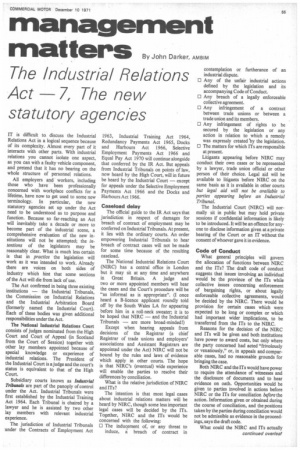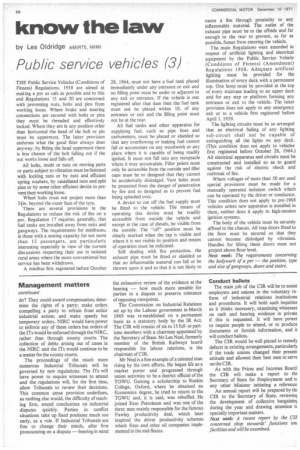management
Page 57

Page 58

If you've noticed an error in this article please click here to report it so we can fix it.
matters By John Darker, AMBIIVI
The Industrial Relations Act —7, The new statutory agencies
IT is difficult to. discuss the Industrial Relations Act in a logical sequence because of its complexity. Almost every part of it interacts with other parts. With industrial relations you cannot isolate one aspect, as you can with a faulty vehicle component, and pretend that it has no bearing on the whole structure of personnel relations.
All employers and workers, including those who have been professionally concerned with workplace conflicts for a lifetime, have now to get used to some new terminology. In particular, the new statutory agencies set up under the Act need to be understood as to purpose and function. Because so far-reaching an Act will inevitably take a decade or more to become part of the industrial scene, a comprehensive evaluation of the new institutions will not be attempted; the intentions of the legislators may be reasonably clear. What is much less certain is that in practice the legislation will work as it was intended to work. Already there are voices on both sides of industry which hint that some sections of the Act will die from lack of use.
The Act confirmed in being three existing institutions — the Industrial Tribunals, the Commission on Industrial Relations and the Industrial Arbitration Board (formerly named the Industrial Court). Each of these bodies was given additional responsibilities under the Act.
The National Industrial Relations Court consists of judges nominated from the High Court and Court of Appeal (in Scotland from the Court of Session) together with other lay members appointed because of special knowledge or experience of industrial relations. The President of the Industrial Court is a judge and the court's status is equivalent to that of the High Court. Subsidiary courts known as Industrial Tribunals are part of the panoply of control under the Act. Industrial Tribunals were first established by the Industrial Training Act 1964. Each Tribunal is chaired by a lawyer and he is assisted by two other lay members with relevant industrial experience.
The jurisdiction of Industrial Tribunals under the Contracts of Employment Act 1963, Industrial Training Act 1964, Redundancy Payments Act 1965, Docks and Harbours Act 1966, Selective Employment Payments Act 1966 and Equal Pay Act 1970 will continue alongside that conferred by the IR Act. But appeals from Industrial Tribunals on points of law, now heard by the High Court, will in future be heard by the Industrial Court — except for appeals under the Selective Employment Payments Act 1966 and the Docks and Harbours Act 1966.
Caseload delay The official guide to the IR Act says that jurisdiction in respect of damages for breach of contract of employment may be conferred on Industrial Tribunals. At present, it lies with the ordinary courts. An order empowering Industrial Tribunals to hear breach of contract cases will not be made for some time because of the resulting caseload.
The National Industrial Relations Court (NIRC) has a central office in London but it may sit at any time and anywhere in Great Britain. A judge and two or more appointed members will hear the cases and the Court's procedure will be "as informal as is appropriate". (I once heard a B-licence applicant roundly told off by the South Wales LA for appearing before him in a roll .neck sweater; it is to be hoped that NIRC — and the Industrial Tribunals — are more broad-minded!) Except when hearing appeals from decisions of the Registrar (a chief Registrar of trade unions and employers' associations and Assistant Registrars are appointed under the Act) NIRC will not be bound by the rules and laws of evidence which apply in other courts. The hope is that NIRC's (eventual) wide experience will enable the parties to resolve their differences by conciliation.
What is the relative jurisdiction of NIRC and ITs?
The intention is that most legal cases about industrial relations matters will be heard by NIRC, though some less important legal cases will be decided by the ITs. Together, NIRC and the ITs would be concerned with the following:
0 The inducement of, or any threat to induce, a breach of contract in
contemplation or furtherance of an industrial dispute.
O Any of the unfair industrial actions defined by the legislation and its accompanying Code of Conduct.
ID Any breach of a legally enforceable collective agreement.
O Any infringement of a contract between trade unions or between a trade union and its members.
• Any infringement of rights to be secured by the legislation or any action in relation to which a remedy was expressly created by the legislation.
O The matters for which ITs are responsible at present.
Litigants appearing before NIRC may conduct their own cases or be represented by a lawyer, trade union official or other person of their choice. Legal aid will be available to litigants before NIRC on the same basis as it is available in other courts but legal aid will not be available to parties appearing before an Industrial Tribunal.
The Industrial Court (NIRC) will normally sit in public but may hold private sessions if confidential information is likely to be introduced. It will be an offence for anyone to disclose information given at a private hearing of the Court or an IT without the consent of whoever gave it in evidence.
Code of Conduct What general principles will govern the allocation of functions between NIRC and the ITs? The draft code of conduct suggests that issues involving an individual would be the province of the ITs while collective issues concerning enforcement of bargaining rights, or about legally enforceable collective agreements, would be decided by the NIRC. There would be provision for certain cases which were expected to be long or complex or which had important wider implications, to be transferred from the ITs to the NIRC.
Reasons for the decision of the NIRC and ITs will be given and both institutions have power to award costs, but only where the party concerned had acted "frivolously or vexatiously," or, in appeals and comparable cases, had no reasonable grounds for bringing the case.
Both NIRC and the ITs would have power to require the attendance of witnesses and the disclosure of documents and to hear evidence on oath. Opportunities would be given to parties involved in actions before NIRC or the ITs for conciliation before the action. Information given or obtained during the course of conciliation, and the positions taken by the parties during conciliation would not be admissible as evidence in the proceedings, says the draft code.
What could the NIRC and ITs actually continued overleaf
do? They could award compensation; determine the rights of a party; make orders compelling a party to refrain from unfair industrial action; and make speedy but temporary orders. NIRC would have power to enforce any of these orders but orders of the ITs would be enforced through the NIRC, rather than through county courts. The collection of debts arising out of cases in the NIRC and the ITs would continue to be a matter for the county courts.
The proceedings of the much more numerous Industrial Tribunals will be governed by new regulations. The ITs will have power to require witnesses to attend and the regulations will, for the first time, allow Tribunals to review their decisions. This common sense provision underlines, as nothing else would, the difficulty of reaching firm, sound conclusions on industrial disputes quickly. Parties in conflict situations take up fixed positions much too early, as a rule. If Industrial Tribunals are free to change their minds, after first pronouncing on a dispute —bearing in mind the exhaustive review of the evidence at the hearing — how much more sensible for parties to a dispute to preserve tolerance of opposing viewpoints.
The Commission on Industrial Relations set up by the Labour government in March 1969 was re-established on a permanent basis as a statutory body by the IR Act. The CIR will consist of six to 15 fullor parttime members with a chairman appointed by the Secretary of State. Mr Len Neal, formerly member of the British Railways board responsible for labour relations, is the chairman of CIR.
Mr Neal is a fine example of a talented man rising by his own efforts. He began life as a market porter and progressed through union activities to be a district official of the TGWU. Gaining a scholarship to Ruskin College, Oxford, where he obtained an Economics degree, he tried to return to the TGWU and, it is said, was rebuffed. He joined Esso Petroleum and was one of the three men mainly responsible for the famous Fawley productivity deal, which later inspired the driver productivity schemes which Esso and other oil companies implemented in the mid-Sixies. Conduct ballots The main job of the CIR will be to assist employers and unions in the voluntary reform of industrial relations institutions and procedures. It will hold such inquiries as it thinks necessary, examining witnesses on oath and hearing evidence in private if this is requested. It will have power to require people to attend, or to produce documents or furnish information, and it will conduct ballots.
The CIR would be well placed to remedy defects in existing arrangements, particularly if the trade unions changed their present attitude and allowed their best men to serve on the CIR.
As with the Prices and Incomes Board the CIR will make a report to the Secretary of State for Employment and tc any other Minister initiating a reference An annual report will be prepared by the CIR to the Secretary of State, reviewini the development of collective bargainini during the year and drawing attention tc specially important matters.
Next week: A recent report by the CII concerned shop stewards' functions am facilities and will be examined.




































































































